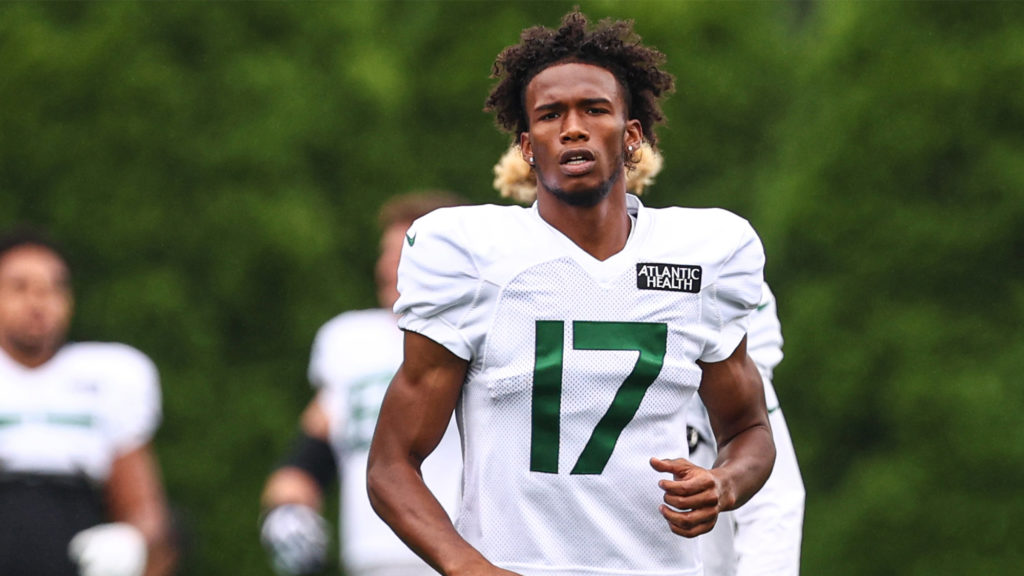The NY Jets offense is loaded with talent, but one main unknown will be the focus of opposing defenses
The New York Jets have not had a quality offense in a long time.
Not since the brief glory days of FitzMagic has this team been capable of pushing the ball downfield with any level of consistency.
This roster has all the pieces in place to change that. Starting with the drafting of Mekhi Becton in 2020, Joe Douglas has steadily built a young core of quick, explosive playmakers whose complementary skills can give defensive coordinators nightmares.
Still, every offense has its weaknesses. Opposing teams will need to come up with a game plan to slow down this offense. And it will all start with the quarterback, as it always does.
Quarterback Zach Wilson struggled as a rookie, and he is the key to the entire Jets’ offense – and likely the success of their season.
Therefore, when an opposing defensive coordinator comes up with a game plan for the Jets, it’s going to start with taking away Wilson’s safety blankets and forcing him to throw the ball.
Breece Hall and Michael Carter make up a potentially lethal one-two running back combination. Both guys excel specifically at making tacklers miss. Carter led the NFL last season with 0.30 missed tackles forced per touch, and in his final college season at Iowa State, Hall’s number in that area was slightly better at 0.31.
The strength of the Jets’ run game is likely going to be inside since their interior offensive linemen are superior outside-zone run blockers. Forcing cutbacks to go all the way outside, especially towards the left, is going to be key. George Fant is the Jets’ weakest run-blocking offensive lineman, and opponents need to exploit that.
When it comes to the passing game, one of Wilson’s biggest struggles was holding on to the ball too long. While this dogs many young quarterbacks, Wilson’s average of 3.05 seconds from snap-to-throw was the fourth-longest among 34 qualifying quarterbacks, per Pro Football Focus. Considering that the other three who held the ball longer are three elusive running QBs in Lamar Jackson, Justin Fields, and Jalen Hurts, it’s clear that Wilson needs to work on getting the ball out of his hands.
To exacerbate that weakness, disguising blitzes and coverages against Wilson is a must. Wilson took 45 sacks last season, and his pressure-to-sack ratio was second-worst among all QBs at 26.3%. Combining unexpected blitzes with coverage that he was not expecting pre-snap will make him hesitate that extra second and force sacks and errant throws.
Furthermore, running a lot of twists and stunts on the defensive line is a good way to test the Jets offensive line. This was Alijah Vera-Tucker‘s biggest struggle as a rookie, and I’d hit that on the right side until Vera-Tucker proves he can capably block them. There were many instances in which a free rusher came right up the middle against Wilson last season, and I’d follow the tape that shows that stunts were one of the biggest culprits.
Additionally, Wilson was the third-to-worst graded quarterback on deep (20+ yard) throws last season, per PFF. Although the Jets have significant speed at receiver in Elijah Moore (4.34 40-yard dash), Garrett Wilson (4.38), Braxton Berrios (4.44), Jeff Smith (4.36), and even Denzel Mims (4.38), until Wilson proves that he can be consistent on deep throws, I’d go with a lot of single-high coverage to help in the box and intermediate areas.
With regard to the Jets’ receivers, I would play a lot of press man coverage on the outside receivers, likely Elijah Moore and Corey Davis. Although Moore proved that he is an excellent X receiver last season, he is still only 5’9″ and 180 pounds. The only reason he fell to the second round of the 2021 Draft was his smaller stature. Pressing him is a must. Although Davis is bigger, he struggles against tight man coverage.
Garrett Wilson will be harder to press in the slot, but he’s also not the most refined route runner as he enters the NFL. Bracketing him with an underneath linebacker in zone coverage may both confuse Zach Wilson into turnovers and throw Garrett Wilson off his route.
The tight ends are real X-factors in this Jets offense. Tyler Conklin and C.J. Uzomah bring value as both blockers and receivers. The best way to neutralize them is to force the Jets to keep them in pass protection. When Michael Carter is on the field and the Jets choose to pass, it’s likely that they will ask one of their tight ends to stay in and block, which automatically lessens Zach Wilson’s targets.
The Jets offense as a whole is a big wild card on this team. Though it has high-ceiling potential, the team as a whole is going to have to prove that they’ve resolved some of the issues that plagued them last season. Keying on those demonstrated weaknesses will help defenses keep the Jets from breaking out of their decade-long slump.







